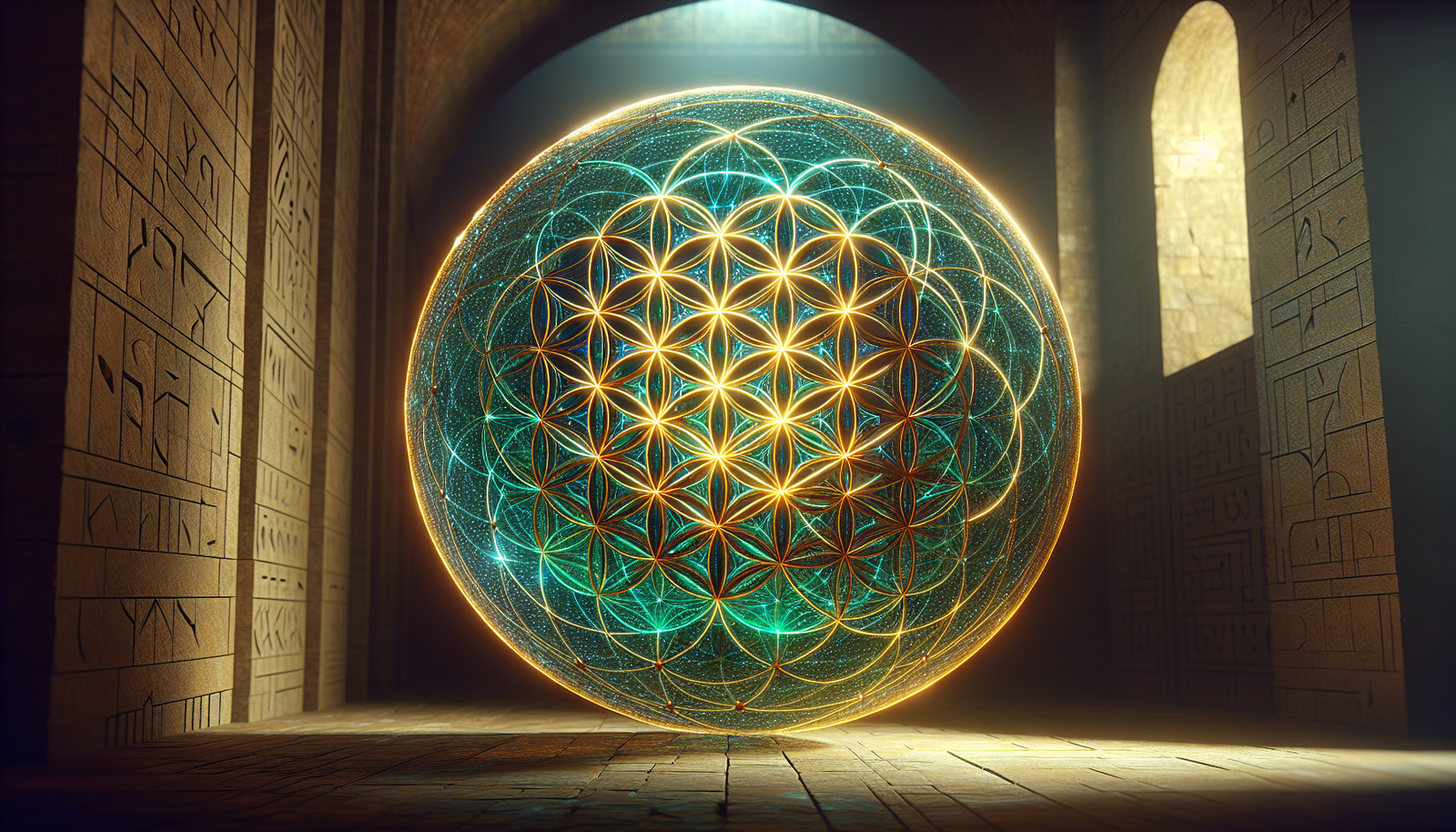Sacred Geometry: Unlocking the Universe's Blueprint

By Sanjay Kapoor, Ufologist
Have you ever gazed upon the perfect, six-fold symmetry of a snowflake, or the vast, spiraling arms of a distant galaxy, or even the intricate patterns within your own eye, and wondered if there’s a connection? What if these seemingly unrelated marvels of nature whisper a shared, hidden language? Could it be that an underlying pattern, a kind of cosmic code, shapes everything we see and much that we don’t?
This is the captivating idea at the heart of Sacred Geometry. It's more than just lines and angles learned in school; it’s the profound belief that specific geometric forms, patterns, ratios, and proportions carry deep spiritual and metaphysical significance. Think of it as the universe's operating system, the fundamental blueprint upon which reality itself is constructed. As Galileo Galilei famously mused, "Mathematics is the alphabet with which God has written the universe." Sacred Geometry seeks to read that alphabet, offering a bridge between the tangible world we perceive and the invisible structures that give it form, linking the realms of science and spirit.
The word "geometry" itself originates from the Greek Geos (Earth) and Metron (To measure), literally "measuring the earth." Ancient priests traditionally restricted this art. Adding the prefix "sacred" elevates this practice beyond mere terrestrial calculation to a cosmic, even divine, understanding. It suggests these shapes and ratios embody absolute truths about the "harmonic structure of the world," as philosopher Pythagoras believed.
What's truly remarkable is the sheer universality of these patterns. We find them echoed across millennia and continents, in cultures that seemingly had no way of communicating. The precise proportions of the Great Pyramid in Egypt resonate with principles found in ancient Greek temples. The intricate mandalas of Hinduism and Buddhism share fundamental patterns with Celtic knots and the rose windows of Gothic cathedrals. Even civilizations separated by vast oceans, like the ancient Egyptians and the Mayans, built pyramids adhering to similar geometric principles. This ubiquity raises fascinating questions: Does this knowledge spring from a universal source? Is it embedded deep within human consciousness? Or is it simply an observable truth about the fabric of reality itself, waiting to be discovered by anyone who looks closely enough?
Let's embark on a journey to explore the history, the core principles, the cornerstone symbols, and the far-reaching implications of Sacred Geometry. Prepare to examine the patterns that structure our world, from the infinitesimal to the infinite.
The Genesis of Form: Basic Principles and Building Blocks
The story of creation, as told through the lens of Sacred Geometry, doesn't begin with a bang, but with stillness – a single, dimensionless point. This is the Monad, the origin, containing infinite potential within itself. Imagine it as the singularity from which physicists believe our universe sprang, or perhaps, the first spark of consciousness in the vast emptiness of the void. It occupies no space, cannot be measured, yet everything is contained within it. Spiritually speaking, it represents oneness, the still observer at the center of being.
From this point of stillness, the first movement occurs – not outwards in a line, but an expansion of awareness in all directions, forming the first circle. The circle, a two-dimensional representation of the sphere, becomes the archetype of unity, wholeness, completeness, and eternity. It has no beginning or end, representing the infinite and the all-encompassing nature of the universe – the "Womb of Creation." Intriguingly, the ratio of a circle's circumference to its diameter gives us Pi (π), an irrational number that never repeats or ends, hinting that the circle's essence transcends the linear logic it contains.
Now, imagine that initial point of consciousness moving to the edge of its own awareness, its spherical boundary, and creating a second, identical circle. Where these two circles overlap, a new shape emerges: the Vesica Piscis. This elegant, almond or fish-shaped form (its Latin name translates to "fish bladder") is profoundly significant. It symbolizes the union of opposites – spirit and matter, heaven and earth, masculine and feminine – the very act of creation emerging from duality. It's seen as the geometric gateway through which light first manifested and, poetically, mirrors the shape through which our own eyes perceive light. This shape contains the inherent ratio of the square root of three (√3), a proportion considered sacred by ancient builders and utilized in countless sacred structures, from Gothic cathedrals to Egyptian temples. You'll recognize echoes of the Vesica Piscis in the Ichthys or "Jesus Fish" symbol of early Christianity, the interwoven loops of the Celtic Triquetra, and the Mandorla aura surrounding holy figures in religious art. Even Freemasons historically employed it as a key symbol in their rituals.
As consciousness continues its journey, moving to the intersection points (nodes) on the circumference and creating new circles, the patterns grow more complex, always maintaining the original radius. The third circle yields the Trinity or Triquetra, the template for the equilateral triangle – the simplest stable 2D shape. By the sixth movement, mirroring the six days of creation in Genesis, a perfect pattern emerges: the Seed of Life. Six circles perfectly surround a central seventh, creating a flower-like design. This symbol, found universally in religious art and architecture, is believed to contain the fundamental recipe for life and all its potential. It’s associated with blessing and protection, representing the seven days of creation, the seven chakras, and the seven notes in a musical scale.
Adding another layer of circles expands the Seed into the Egg of Life. Visualized in three dimensions, this pattern forms eight spheres arranged in a cubic formation. This structure is remarkable because it mirrors the eight-cell stage observed in the embryonic development of all mammals – a critical point where cellular transformation begins. It's believed to be the structural framework for life, music (the eight tones of an octave), and the very dimensions of space.
One more rotation, building upon the Egg of Life to a total of 19 interlocking circles within a larger boundary, reveals the magnificent Flower of Life. This is arguably the most iconic symbol of Sacred Geometry. Its presence is global and ancient, found etched onto a 6,000-year-old granite temple wall in Abydos, Egypt, carved into ancient synagogues in Israel, decorating Buddhist temples in China and Japan, appearing in Mayan ruins, and beneath the protective paws of Fu Dogs guarding the Forbidden City in Beijing. The Flower of Life is considered the ultimate blueprint of the universe, visually expressing the interconnectedness of all existence. Its perfect hexagonal symmetry underlies the structure of crystals and molecules. Leonardo da Vinci was captivated by it, studying its mathematical proportions and exploring its connection to physical space and human consciousness; scholars believe it heavily influenced his famous "Vitruvian Man" drawing. The symbol is said to contain all fundamental mathematical formulas and geometric laws. Ancient wisdom traditions believed the knowledge held within the Flower of Life was so powerful, revealing the mysteries of creation, that it had to be kept secret.
From the extended pattern of the Flower of Life, a configuration of 13 full circles can be extracted: the Fruit of Life. This is considered incredibly sacred, perhaps the "Holiest of Holies," representing the blueprint from which all forms in the universe can be derived. Often considered a feminine pattern due to its curved lines, the number 13 itself carries significance across cultures, symbolizing transition, fertility, abundance, and the completion of one cycle to begin another – like the 13th note starting a new musical octave.
When you take the Fruit of Life and connect the center of each of its 13 circles to the center of every other circle using straight lines, a new, highly complex figure emerges: Metatron's Cube. Named after the Archangel Metatron, often described as the celestial scribe who records the deeds of humanity, this symbol is believed to hold the very fabric of reality. It represents the perfect integration of the feminine (circles) and masculine (straight lines) energies, resulting in a balanced and harmonious whole. Crucially, the shadow projections of all five Platonic Solids – the fundamental building blocks of the physical universe – are contained within Metatron's Cube.
The Elements of Existence: The Platonic Solids and Beyond
Central to the understanding of Sacred Geometry are the five Platonic Solids. These aren't just any 3D shapes; they are the only perfectly regular convex polyhedra possible in three dimensions. This means each one is constructed from identical faces (equilateral, equiangular polygons like triangles, squares, or pentagons), all edges are the same length, and all angles where faces meet are identical. What's more, each of these five shapes fits perfectly inside a sphere, with all its vertices touching the sphere's inner surface.
The ancient Greeks, particularly the philosopher Plato (hence the name), associated these unique forms with the fundamental elements believed to make up the universe:
- Tetrahedron: Four triangular faces. Symbolized Fire.
- Hexahedron (Cube): Six square faces. Symbolized Earth.
- Octahedron: Eight triangular faces. Symbolized Air.
- Icosahedron: Twenty triangular faces. Symbolized Water.
- Dodecahedron: Twelve pentagonal faces. Symbolized Aether (or Spirit, the Universe itself). Plato intriguingly suggested the cosmos was shaped like this, "used for arranging the constellations on the whole heaven."
While Plato formalized their study around 2,500 years ago, evidence suggests a much older awareness. Hundreds of carved stone spheres, dating back over a thousand years before Plato, have been unearthed in Scotland. Remarkably, over 75% of these mysterious artifacts represent one of the five Platonic Solids. This discovery pushes back the timeline of geometric understanding and hints at a deep, ancient wisdom. Fast forward to modern science, and we find another fascinating correlation: these very shapes relate to the arrangement of protons and neutrons within the atomic nuclei of the elements in the periodic table, suggesting these forms are truly fundamental to physical structure.
But geometry doesn't stop at three dimensions. Though difficult for our 3D-attuned minds to visualize fully, mathematicians have described higher-dimensional analogues of the Platonic Solids – 4D shapes like the tesseract (a 4D cube). Contemplating these forms offers a glimpse into the potential harmony and order of realities beyond our everyday perception.
One shape that bridges dimensions and embodies dynamic energy is the Torus. Imagine a donut shape where the hole in the middle closes to a single point. It represents a continuous, self-sustaining flow of energy: moving inward through one end, circulating around the surface, and flowing out the other, constantly cycling back upon itself. This pattern is ubiquitous, appearing at nearly every scale imaginable:
- The electron clouds surrounding atomic nuclei.
- The electromagnetic field generated by the human heart.
- The magnetic field protecting the Earth, flowing from pole to pole.
- The structure of whirlpools, tornadoes, and even entire galaxies.
The Torus is considered a 4D form because it represents energy in motion, incorporating time, and allowing for the simultaneous existence of an 'inside' and an 'outside'. It's associated with the energy flow of chakras, auras, the cycles of life, and the concept of infinity.
Another potent multidimensional form is the Merkaba. Often visualized as a three-dimensional Star of David, it consists of two interlocking tetrahedrons – one pointing upwards (representing masculine, cosmic energy) and one pointing downwards (representing feminine, earth energy) – rotating in opposite directions. Its name may derive from ancient Egyptian words: Mer (light), Ka (spirit), and Ba (body), translating to "light-spirit-body" or, more evocatively, "chariot of light." This symbol is deeply rooted in ancient Jewish mysticism (Merkabah mysticism focused on divine ascent) and potentially Egyptian spiritual science. When activated, it's believed to create a powerful, counter-rotating energy field around the body (extending out many feet) that serves as a vehicle for spiritual protection, ascension, consciousness expansion, and harmonizing earthly and cosmic forces. Importantly, sources emphasize that authentic Merkaba activation isn't just a mental visualization but involves specific breathwork, physical postures (mudras), and a state of aligned consciousness.
Nature's Signature: Sacred Geometry in the Natural World
Perhaps the most compelling evidence for the principles of Sacred Geometry lies not in ancient texts or mystical diagrams, but in the world all around us. Nature, it seems, employs geometry as its preferred design language, showcasing these patterns with breathtaking elegance and efficiency.
The most celebrated example is the relationship between the Fibonacci Sequence and the Golden Ratio (Phi - φ). The sequence starts simply: 1, 1, 2, 3, 5, 8, 13, 21... each number being the sum of the two before it. As the sequence progresses, the ratio between consecutive numbers approaches the Golden Ratio, an irrational number approximately equal to 1.618. This "divine proportion" manifests everywhere growth occurs:
- Spirals: The logarithmic spiral, governed by Phi, is perfectly embodied in the growing shell of the Chambered Nautilus. It appears in the arrangement of seeds in a sunflower head, the scales on a pinecone, the swirling arms of galaxies, and the powerful dynamics of hurricanes and whirlpools.
- Plant Growth: The sequence dictates the number of petals on many flowers (lilies have 3, buttercups 5, delphiniums 8, marigolds 13, asters 21...), the branching patterns of trees, and the arrangement of leaves around a stem, optimizing sun exposure.
- Human Anatomy: The proportions of the human body often reflect the Golden Ratio. Think of the relationship between the forearm and hand, the sections of a finger, or the proportions of the face. Leonardo da Vinci's Vitruvian Man is a famous exploration of these ideal human proportions, deeply connected to geometric principles.
But the Golden Ratio is just one thread in nature's geometric tapestry. Consider the simple snowflake: each one, despite its unique intricate detail, adheres to a strict hexagonal (six-sided) symmetry, a fundamental shape found repeatedly in Sacred Geometry constructs like the Flower of Life. Or look at a honeycomb: bees instinctively build hexagonal cells, not just because they're beautiful, but because it's the most efficient way to tile a surface, maximizing storage space while minimizing the wax used – a perfect example of geometric optimization in action.
Even at the microscopic level, geometry reigns. The DNA double helix itself is a spiral structure. And extending the resonance of numbers, the 64 codons that form our genetic code find a curious echo in the complex structure known as the 64-Tetrahedron Grid, a shape representing the masculine counterpart to the Flower of Life in some interpretations of Sacred Geometry.
Looking outwards to the cosmos, the patterns persist. The idea of a "Harmony of the Spheres," dating back to Pythagoras and Plato and later explored by Johannes Kepler, proposed that the distances, movements, and relationships between planets weren't random but followed mathematical, even musical, ratios. While modern astrophysics uses different models, the underlying search for mathematical harmony in the cosmos continues. A truly fascinating example is the orbital dance of Venus and Earth: over eight Earth years, Venus completes thirteen orbits. When viewed from Earth, the path Venus traces against the backdrop of the zodiac creates a near-perfect five-pointed star, or pentagram – a shape intrinsically linked to the Golden Ratio. Nature, it seems, signs its work with a geometric flourish, from the tiniest cell to the grandest celestial ballet.
Echoes of the Divine: Sacred Geometry in Human Creations
Humans, perhaps intuitively recognizing these fundamental patterns, have consistently incorporated Sacred Geometry into their own creations throughout history. It's as if we are driven to replicate the harmony we observe in nature, embedding it within our art, our buildings, and our sacred spaces, believing it connects us to something larger than ourselves.
The most monumental examples come from ancient architecture. The Pyramids of Giza in Egypt are not just tombs; they are geometric marvels, encoding proportions like the Golden Ratio (Phi) in the ratio of their apothem to half-base length, and aligning with stunning astronomical precision, famously mirroring the stars of Orion's Belt. Similar geometric sophistication and celestial awareness are found in the pyramids built by Mayan and other Mesoamerican cultures. Greek temples, like the Parthenon, are renowned for their use of harmonious ratios, designed according to principles laid out by architects like Vitruvius, aiming for beauty, durability, and utility through mathematical proportion.
But perhaps one of the most mind-bending examples resides not in stone, but in earth, right here in North America: the Hopewell Earthworks in Ohio. Constructed over 2,000 years ago by a culture without metal tools, these vast ceremonial sites display a level of geometric and astronomical knowledge that is frankly staggering. The massive Octagon earthwork aligns perfectly with the northernmost rising point of the Moon, an event that occurs only once every 18.6 years – a cycle the Hopewell people clearly understood and tracked. Nearby, the Great Circle, sprawling across 1,200 feet, is engineered with such precision that its circumference precisely matches that of a square it was once connected to. The scale and accuracy are so remarkable that one source title even claims NASA wouldn't believe it. These weren't isolated structures; they were part of a vast network connected by sacred roads lined with earthen walls, hinting at pilgrimages and a society deeply unified by these geometric principles and their cosmic connections.
This practice of embedding Sacred Geometry continued into the design of religious buildings across faiths and eras. Medieval cathedrals in Europe often used the cross as a floor plan and incorporated complex geometric patterns, like the Flower of Life, in stained glass and tracery, attempting to create spaces that resonated with divine order. Mosques feature breathtaking geometric tiling (often based on the Flower of Life grid and featuring stars with 8, 12, or more points), reflecting Islamic traditions where geometric patterns represent the infinite nature of the divine without using figurative imagery. Temples and synagogues worldwide similarly utilize geometric principles in their layouts and decorations, aiming to create environments conducive to spiritual experience and connection.
In art, the influence is equally profound. We've mentioned Leonardo da Vinci and his fascination with the Flower of Life and the Golden Ratio, evident in Vitruvian Man and potentially the composition of The Last Supper. But eastern traditions offer even more explicit examples. Mandalas (Sanskrit for "circle") in Hinduism and Buddhism are complex geometric diagrams, often circular and highly symmetrical, used as tools for meditation and representing the cosmos or deities. Yantras are similar geometric designs used in Tantric traditions as visual aids for focusing consciousness and invoking specific energies.
The patterns extend even to sound. The ancient concept of the Harmony of the Spheres explicitly linked planetary movements to musical intervals and ratios. Modern explorations like Cymatics (the study of visible sound vibration) demonstrate how frequencies create intricate geometric patterns in mediums like sand or water – beautiful visual proof of the inherent geometry of sound waves.
And Sacred Geometry isn't merely a relic of the past. Its principles are being rediscovered and applied today. You might find them influencing the design of energy-efficient sustainable architecture, the algorithms behind computer graphics, the fractal patterns in digital art, or even the harmonious design of corporate logos (think Mercedes-Benz or Apple). There's a notable resurgence of interest within spiritual and wellness communities, where these shapes are used in meditation, energy healing, jewelry design, and as tools for personal growth and achieving inner balance. The resonance of these ancient patterns clearly continues to echo in the modern world.
The Spiritual Heart: Meaning and Mysticism
Beyond the elegant mathematics and the tangible presence in nature and art, Sacred Geometry resonates deeply on a spiritual and metaphysical level for many seekers. It's perceived not just as a description of the universe, but as a key to understanding its deeper meaning and our connection to it.
Think of it as the native language of the Divine. If the universe was indeed designed, Sacred Geometry is seen as the vocabulary and syntax used by the Creator. Understanding this language allows us to comprehend the underlying thoughts, the fundamental principles that govern existence. It provides a framework for seeing the divine order manifesting in the physical world.
From this perspective, Sacred Geometry acts as the blueprint of creation. It doesn't just describe patterns; it is the pattern from which all form emerges from undifferentiated energy or consciousness. Each shape, each ratio, is believed to be a vibrational signature, a creative 'word' spoken by Source, organizing energy into the structures we perceive as reality. Studying these forms becomes a way to trace creation back to its origins, to understand how the cosmos unfolds according to precise, harmonious laws.
Engaging with these patterns is therefore seen as a path toward connecting with higher consciousness. Meditating on a mandala, drawing the Flower of Life, or contemplating the perfection of a Platonic Solid isn't merely an intellectual exercise; it's believed to attune the practitioner's own energy field to the higher frequencies embodied by these forms. It's a way to tap into universal energies, balance one's own inner landscape, and potentially achieve states of expanded awareness or enlightenment. The shapes themselves are considered tools for healing, transformation, and awakening.
Each geometric form becomes a symbolic key, unlocking deeper layers of meaning. The circle speaks of unity and the infinite. The square grounds us in the stability of the material world. The triangle embodies balance and ascension. The spiral signifies growth and the evolutionary journey of the soul. These symbols act as codes, providing pathways to connect with our "highest self" and understand our place within the grand cosmic design.
An intriguing concept found in ancient traditions, particularly Egyptian mystery schools, is that of "The Net." This wasn't a physical net, but an invisible matrix of energy, the underlying grid upon which physical reality crystallizes through the patterns of Sacred Geometry. Those initiated into these mysteries, the "masters of the net," were believed to understand this energetic fabric and, according to texts like the Westcar Papyrus, could learn to manipulate it, performing feats that seemed magical, like controlling natural forces. Some interpretations even suggest the opening lines of Genesis in Hebrew, "Bereshit," could be understood as "God creates the Net" as the first act of creation. This idea posits an energetic reality more fundamental than the physical, governed by geometric laws.
This naturally leads to the exploration of higher dimensions. If the geometric forms we perceive are potentially just shadows or projections of more complex realities existing in higher dimensions, then engaging with Sacred Geometry could be a way to bridge that gap, to intuitively grasp or even interact with these unseen realms. The Torus and Merkaba are often discussed in this context, as forms that inherently involve movement, transformation, and dimensions beyond our standard three.
Ultimately, this transforms Sacred Geometry from a passive subject of study into an active spiritual practice. Like meditation, prayer, or yoga, the act of drawing, contemplating, or visualizing these forms becomes a discipline for self-development. It's a method for aligning one's own consciousness with the perceived harmony and order of the universe, fostering inner peace, clarity, and a profound sense of interconnectedness. The rediscovery of these patterns isn't just about historical curiosity; it's about accessing timeless tools for personal and spiritual evolution.
Navigating the Path: Skepticism and the Quest for Truth
It's crucial to acknowledge that while Sacred Geometry inspires deep reverence and fascination in many, it also attracts skepticism, particularly regarding its more metaphysical interpretations. Not everyone agrees that the patterns found in shells, galaxies, and ancient temples are evidence of a divine blueprint or a hidden cosmic language.
Some critics, including scientists like astrophysicist Mario Livio, argue that many perceived connections are simply coincidental or contrived. They suggest that proponents might be engaging in pattern-seeking, drawing lines "conveniently" or finding ratios that are mathematically convoluted rather than genuinely fundamental. From this perspective, the appearance of hexagons in honeycombs or spirals in shells is the logical and efficient outcome of natural physical laws and evolutionary processes, rather than proof of a mystical design.
Furthermore, the sources and claims of some prominent figures within the modern Sacred Geometry movement, like Drunvalo Melchizedek, have been questioned regarding their historical accuracy and mathematical rigor. Claims of receiving knowledge directly from angels or ancient deities, while compelling to believers, fall outside the realm of scientific verification and lead to skepticism about the foundations of some teachings.
This highlights an ongoing dialogue – and sometimes a distinct tension – between rigorous scientific inquiry, which demands empirical evidence and testability, and spiritual or metaphysical beliefs, which often rely on intuition, symbolism, and subjective experience. Sacred Geometry sits squarely at this intersection.
However, regardless of one's stance on the "sacred" aspect, the "geometry" itself remains undeniably real and fascinating. The recurrence of specific mathematical constants like Phi, the prevalence of certain shapes like hexagons and spirals, and the inherent symmetries found throughout the natural world are observable facts. These patterns continue to fuel scientific research in fields ranging from crystallography and biology to materials science and cosmology. They demonstrate an underlying order and elegance in the universe that inspires wonder, whether attributed to divine intention or the inherent beauty of physical laws.
Ultimately, the journey into Sacred Geometry is a personal one. The true value may lie not in definitively proving or disproving its grandest claims, but in the act of observation and contemplation it encourages. It invites us to look more closely at the world around us, to appreciate the intricate patterns in a flower petal or the vast structure of a galaxy, and to consider the profound interconnectedness that binds the universe together. It is a path of discovery, offering a unique lens through which to perceive reality and our place within its magnificent, geometrically ordered tapestry.
From Bigfoot to UFOs: Hangar 1 Publishing Has You Covered!
Explore Untold Stories: Venture into the world of UFOs, cryptids, Bigfoot, and beyond. Every story is a journey into the extraordinary.
Immersive Book Technology: Experience real videos, sights, and sounds within our books. Its not just reading; its an adventure.


























